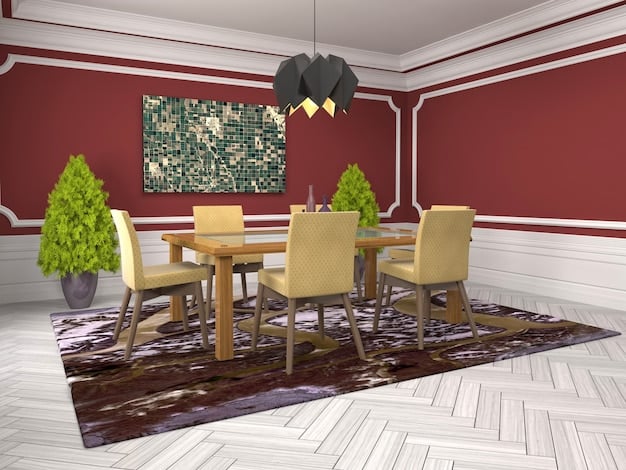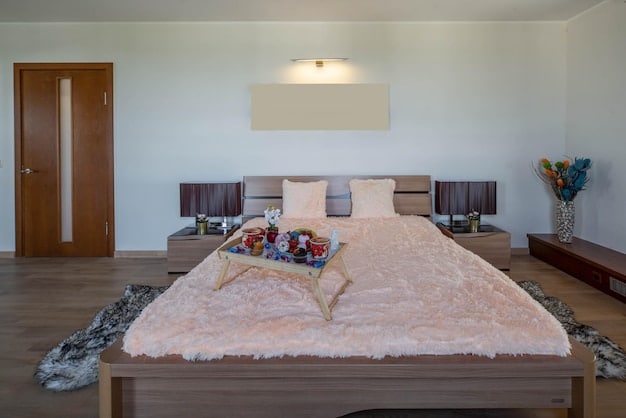Rug Size Guide: Interior Designer Tips for Every Room

Choosing the right rug size is crucial for interior design; this expert guide provides room-by-room advice to help you select the perfect rug dimension, enhancing space and tying decor together.
Selecting the right rug size can transform a room, creating a sense of harmony and pulling your décor together. However, navigating the myriad of options can feel overwhelming. This guide will help you understand how to choose the right rug size for every room based on expert interior design principles.
Understanding Rug Size Basics
Choosing the right rug size can significantly impact the overall look and feel of a room. A rug that is too small can make a space feel disjointed, while one that is too large can overwhelm it. Knowing the basics will set you up for success.
The Importance of Proportion
Proportion is key. A rug should complement the size and shape of the room. Consider the furniture arrangement and how the rug will interact with it.
Common Rug Sizes
Familiarize yourself with standard rug sizes such as 5×8, 8×10, 9×12, and larger options like 10×14. Understanding these dimensions will help you visualize how they fit in different rooms.
- 5×8 rugs are ideal for small spaces like entryways or under coffee tables in small living rooms.
- 8×10 rugs work well in standard-sized living rooms or bedrooms, grounding the main seating or bed area.
- 9×12 rugs are suitable for larger living rooms or dining rooms, providing ample coverage under furniture.
- 10×14 rugs are best for very large, open-concept spaces to define a seating or dining area.
A well-proportioned rug ties the room together, enhancing its aesthetic appeal.

Living Room Rug Placement
The living room often serves as the heart of the home, making rug selection especially important. The placement of your rug can define the seating area and enhance the room’s overall ambiance.
All Legs On
In a larger living room, placing all furniture legs on the rug creates a cohesive and luxurious feel. The rug should extend beyond the seating area to visually expand the space.
Front Legs On
A common approach is to place only the front legs of the sofa and chairs on the rug. This method defines the seating area while leaving some floor space exposed, suitable for medium-sized rooms.
Floating Rug
In smaller living rooms, a smaller rug can float in the center of the seating area, with only the coffee table resting on it. This approach keeps the space from feeling cramped while still adding warmth and texture.
By thinking about the space you want to fill, and the message you want to convey, you can select the best option.
Bedroom Rug Dimensions
In the bedroom, a rug can add warmth and comfort, making it a cozy retreat. The size and placement of the rug should be chosen to complement the bed and other furniture.
Under the Entire Bed
For a luxurious feel, place a large rug under the entire bed, extending beyond the sides and foot of the bed. This works best in larger bedrooms where the rug can define the entire sleeping area.
Two-Thirds Under the Bed
A popular option is to place the rug under the bottom two-thirds of the bed, leaving the headboard and nightstands on the bare floor. This approach provides warmth underfoot while saving on rug costs.
Runners on the Sides
Runners placed on either side of the bed offer comfort and style without the need for a large area rug. This works well in smaller bedrooms or when you want to highlight the flooring.

Dining Room Rug Guidelines
A rug in the dining room can protect your flooring and add a touch of elegance. The key is to choose a rug that is large enough to accommodate all chairs, even when they are pulled out from the table.
Size Matters
Ensure the rug extends at least 24-36 inches beyond the table’s edge on all sides. This allows chairs to remain on the rug even when guests are seated, preventing wobbling and protecting the floor.
Shape Considerations
A rectangular rug works best with a rectangular table, while a round rug complements a round table. Matching the rug shape to the table shape creates a harmonious and balanced look.
Material Choice
Opt for a durable and easy-to-clean material, as dining rooms are prone to spills. Wool, synthetic fibers, or indoor-outdoor rugs are excellent choices.
Planning is key when looking at the correct rug size.
Entryway and Hallway Runners
Entryways and hallways benefit from runners, which can add style and protect high-traffic areas. The right size runner can also visually lengthen or widen these spaces.
Length and Width
Choose a runner that is long enough to cover the majority of the hallway or entryway. The width should leave enough exposed flooring on either side to avoid a cramped feeling.
Material and Durability
Select a durable and easy-to-clean material, as these areas experience heavy foot traffic and are prone to dirt and debris.
Pattern and Design
Consider a pattern or design that complements the surrounding décor and adds visual interest to the space. A well-chosen runner can make a hallway or entryway feel more inviting and stylish.
Home Office Rug Strategies
In a home office, a rug can define the workspace and add comfort underfoot. The rug size should be chosen based on the size of the office and the furniture arrangement.
Under the Desk
Place the rug entirely under the desk and chair, ensuring the chair can move freely without rolling off the rug. This defines the workspace and protects the flooring.
Partial Coverage
If the office is large enough, extend the rug beyond the desk area to create a more inviting and comfortable workspace. This can also help absorb sound in the office.
Material and Comfort
Opt for a comfortable and durable material, as you’ll likely be spending a lot of time in this space. Wool or a wool blend can provide both comfort and durability.
| Key Point | Brief Description |
|---|---|
| 📏 Room Size | Match rug size to the room for visual harmony. |
| 🛋️ Furniture | Consider furniture placement when selecting rug size. |
| 🚪 Entryways | Use runners to protect and style high-traffic areas. |
| 🪑 Dining Rooms | Ensure rugs extend beyond chairs for functionality. |
Frequently Asked Questions
▼
The standard rug size for a living room is typically 8×10 or 9×12 feet, depending on the size of the seating area and the overall dimensions of the room. Ensure it either covers the entire seating area or sits under the front legs of the main furniture.
▼
In a bedroom, you can place a rug entirely under the bed, two-thirds under the bed, or use runners on either side of the bed. The best option depends on the size of the room and your personal style preferences.
▼
For a dining room, the rug should extend at least 24-36 inches beyond the table’s edge on all sides. This ensures that the chairs remain on the rug even when pulled out, protecting the floor and preventing wobbling.
▼
Measure the length of the hallway and choose a runner that covers most of it, leaving some exposed flooring on either side. The width should allow for comfortable movement without feeling cramped, typically 2-3 feet wide.
▼
For high-traffic areas, opt for durable and easy-to-clean materials such as wool, synthetic fibers, or indoor-outdoor rugs. These materials can withstand heavy foot traffic and are resistant to stains and wear.
Conclusion
Choosing the right rug size for each room in your home involves careful consideration of room dimensions, furniture placement, and personal style. By following these interior designer guidelines, you can create harmonious and inviting spaces that reflect your unique taste and lifestyle.





